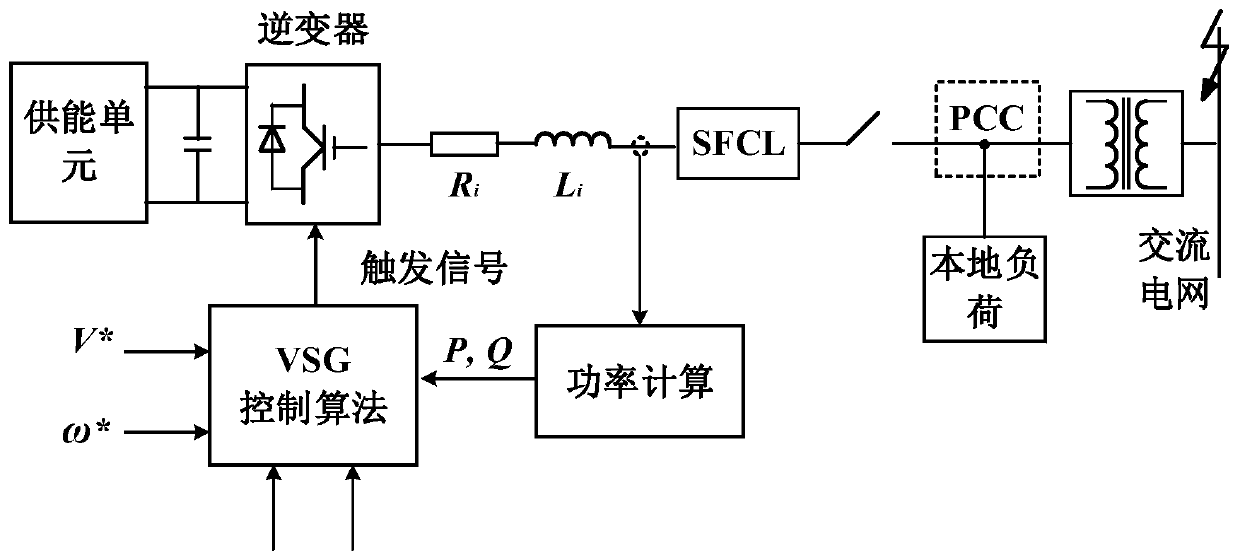System and method of improving VSG low-voltage ride-through capability based on magnetic flux coupling type SFCL
A low voltage ride through and magnetic flux coupling technology, applied in emergency protection circuit devices for limiting overcurrent/overvoltage, usage of superconductor elements, electrical components, etc., can solve the problem of low voltage ride through and withstand transient current Weak ability to impact, etc.
- Summary
- Abstract
- Description
- Claims
- Application Information
AI Technical Summary
Problems solved by technology
Method used
Image
Examples
example 1
[0076] Example 1: A three-phase metallic fault occurs in the virtual synchronous generator VSG at t=1s, and the fault duration is 200ms. The resistance R of the superconducting coil of non-flux-coupled SFCL and flux-coupled SFCL SC When it is set to 0.5Ω, 1.0Ω, and 2.0Ω, the short-circuit current of each phase of the virtual synchronous generator VSG is simulated. The A-phase, B-phase and C-phase short-circuit currents of the virtual synchronous generator VSG shown in Fig. 5(a), Fig. 5(b) and Fig. 5(c) are obtained.
example 2
[0077]Example 2: The virtual synchronous generator VSG has a three-phase metallic fault at t=1s, and the fault lasts for 200ms. The resistance R of the superconducting coil of non-flux-coupled SFCL and flux-coupled SFCL SC When it is set to 0.5Ω, 1.0Ω, and 2.0Ω, the active power output of the virtual synchronous generator VSG is simulated, and the transient behavior of the virtual synchronous generator VSG shown in Figure 6(a) is obtained. The frequency of virtual synchronous generator VSG is simulated, and the transient behavior of virtual synchronous generator VSG shown in Fig. 6(b) is obtained.
example 3
[0078] Example 3: The virtual synchronous generator VSG has a three-phase metallic fault at t=1s, and the fault lasts for 200ms. The three-phase voltage of the virtual synchronous generator VSG is simulated respectively when there is no magnetic flux coupling SFCL, and the three-phase voltage of the virtual synchronous generator VSG shown in Fig. 7(a) is obtained.
[0079] The resistance R of the flux-coupled SFCL superconducting coil SC When it is set to 2.0Ω, the three-phase voltage of the virtual synchronous generator VSG is simulated, and the three-phase voltage of the virtual synchronous generator VSG shown in Figure 7(b) is obtained.
PUM
 Login to View More
Login to View More Abstract
Description
Claims
Application Information
 Login to View More
Login to View More - R&D
- Intellectual Property
- Life Sciences
- Materials
- Tech Scout
- Unparalleled Data Quality
- Higher Quality Content
- 60% Fewer Hallucinations
Browse by: Latest US Patents, China's latest patents, Technical Efficacy Thesaurus, Application Domain, Technology Topic, Popular Technical Reports.
© 2025 PatSnap. All rights reserved.Legal|Privacy policy|Modern Slavery Act Transparency Statement|Sitemap|About US| Contact US: help@patsnap.com



